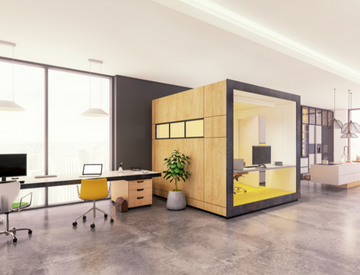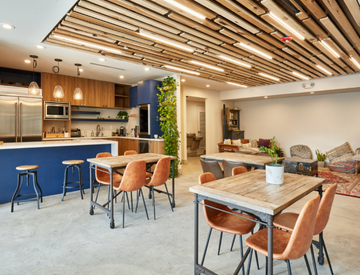Back to Work: Accommodating Employees with Hybrid Workspaces
Each year, the fall season prompts “back to” feelings — back to school, work, or other regular routines after a fun-filled summer. This year, the season might look and feel very different for many businesses that are establishing more permanent hybrid working schedules and environments for their employees.
In this blog, we cover some general basics about hybrid work, why it’s valuable to employees, and how to create an office that accommodates remote workers and those who may still want to work in person.
What is Hybrid Work?
Hybrid work, often referred to as remote work or working from home, is a flexible approach that allows employees to split their time between working in the office and working from another location (often at home). Hybrid work varies in flexibility and there are several different types of hybrid work policies that companies are implementing.
Some companies prefer hybrid at-will, which means employees can choose which day(s) to come to the office or split-weeks, which means companies assign specific days for on-site and remote work by team or function. There’s also the option that a manager might choose the days their team comes to the office or some combination of all these options, and more. Hybrid work can look like pretty much anything.
The number one purpose of a hybrid workplace is to give employees flexibility in how and where they work. This can offer employees a better work-life balance. If your company chooses to incorporate hybrid work permanently, employees should be able to alternate between home and the office seamlessly — without a dip in productivity.
The Value Hybrid Work
The option to work remotely has become a significant factor in where people choose to work. In response, more companies are offering flexible hours and remote work to help retain employees. A survey conducted with Wakefield Research shows that almost half of employees (47%) would likely look for another job if their employer doesn’t offer a flexible working model.
So it’s no surprise that data from an April 2022 survey by Envoy showed that 77% of companies have already opted to go hybrid. What’s more, 56% of those companies are allowing employees to choose when and how often they wish to come into the office.
1. Employees work when and how they're most productive.
In a full-time office-based model, people are expected to be in the office working during normal business hours every workday. In a hybrid work model, employees often have a little more flexibility to get work done when and where they’re most productive. For example, some people work best early in the morning while others do better in the evening. A hybrid work model means that employees can have the option to work with colleagues on-site or get some heads-down work done from a remote location.
2. Employees often have better work-life balance.
According to the Return to Workplace Report, 63% of employees surveyed said flexibility would make them feel more empowered. And according to Slack, it’s a key reason why employees are attracted to the hybrid work model. Finding a balance between life and work is easier with a flexible work arrangement. When employees have more control over their work schedules, they can create schedules that are conducive to getting work done and being present in their personal lives.
How can you make a hybrid design for your office work?
A hybrid office, sometimes referred to as flex office space or flex space, is the type of space that accommodates both remote and traditional office workers. In previous years, hybrid offices were ideal for startups with flexible requirements, tech companies that predominantly worked remotely, or growing businesses that wanted to offer a variety of options for employees.
However, since the onset of the COVID-19 pandemic, more and more companies of all sizes have reevaluated their office space and considered a hybrid arrangement. Companies aren’t just scaling back offices because more people are working remotely. Many companies are designing their spaces to act more as social and cultural spaces — a place for meetings and holding events — rather than a place for deep work. Here’s a look at how you can make a hybrid for your office space:
Optimize Your Office Design
When designing a hybrid office, companies may not need the same volume of furniture or amenities or utilize their space in a conventional way. The goal is to create a space that is functional for their team, regardless of how they decide to work.
For example, conference rooms used to be a staple for every business with an office. However, more companies are breaking out of the traditional conference room design and incorporating smaller rooms, smaller tables, and even shifting toward phone booth or private booth options that provide the same level of utility and privacy that conference rooms once did. These options can be more cost-effective, convenient, and sustainable in the long run.
This isn’t to say that conference rooms are no longer useful, companies wanting to redesign their space to accommodate a hybrid model must strike a balance between openness and privacy, and incorporate design elements that enable social interactions of many types — from a quick chat to collaboration sessions to presentations.
Another design trend emerging frequently as companies shift to hybrid working models is “hot desking.” Employees can choose to sit from a pool of desks on any given day, at any given time. This is one way a company can eliminate unnecessary rows of unused workstations to consolidate space and maximize functionality. A hot desk hub could be the focal point for an open-plan office that has a mix of individual workstations and blocks of desks for teams. The spaces often include moveable partitions to enhance privacy and allow employees to fully customize the space as needed.

Read More ➡️ Top Trends of NeoCon 2022
Incorporate Technology that Enables Productivity
The right hybrid workplace technology is essential to support today’s new workplace reality. It’s important that companies looking to implement a hybrid model evaluate their current technology and consider their employee experience. Security, communication, collaboration, and connectivity are all important considerations. A hybrid office can be completely customized by the technology that it incorporates, everything from advanced network security, upgraded audio-visual technology for video conferencing, cross-device integrations, cloud-based document management, digital whiteboards, co-working apps, and more. Companies are also ensuring their physical space supports employees through smart furniture, booking system technologies, and other solutions that meet employees’ needs and preferences for working.
Consider Employee-Centric Furniture Solutions
Hybrid offices are a perfect showcase for the future of furniture and the need for customizable arrangements that allow for collaboration. Hybrid offices need thoughtful, employee-centric office furniture. The goal is to maximize and optimize office layout space, minimize office noise and distractions, and keep employees focused and productive. This often looks like a variety of desks, tables, and seating arrangements for the various ways that people need to work. Standing desks, collaboration tables, and solo pods for quiet work. Furniture solutions need to be flexible enough that employees can piece together a working environment that enables them to do their best work when they are in the office. With highly intentional furniture options, companies with a hybrid work model can explore how to reconfigure their space and furniture to promote interaction.

Use Your Office as a Social Anchor
Despite the staggering popularity of hybrid and remote work, it’s important to note that companies won’t suddenly abandon their office space — going to the office has never just been about doing the work. Offices are a place of collaboration and social interaction, and because of the nature of the setting, allow for natural breaks in the day versus back-to-back meetings or calls of a remote workday.
Companies should take extra care in making their physical office space attractive to employees, a place they want to work in (even if it’s only occasionally). One way several companies are reimagining their office as the “social anchor” of their organization is by updating the office beyond workstations and conference rooms. Trends are shifting toward scaling up break rooms and kitchen/dining areas to incorporate cozier, “catch-up” space. This includes kitchen islands with stools, sofa space with coffee tables, etc. This point is to create spaces that are comfortable and homey, where employees can chat, have lunch, and socialize with co-workers in ways they can’t when working remotely. Overall the goal should be to design your office in a way that fosters face-to-face encounters that aren’t possible with remote work.

Hybrid Work is Here to Stay
Hybrid work has taken the world by storm in recent years, but understandably so. The flexibility and work-life balance that it fosters are important to employees. According to the 2021 State of Remote Work report by Owl Labs, one in three employees said they would quit if forced to give up remote work. A 2021 survey by PwC found that 55% of workers would prefer a hybrid work model where they worked from home three or more days a week.
And employees are not alone in the desire for hybrid work. Executives have also realized that a hybrid workplace is the future. In the PwC survey, only 20% of executives wanted a return to full-time, in-office work. The majority, 29%, preferred a three-day in-office work week. Globally, 72% of corporate leaders said they plan to offer a hybrid model.
Employers are increasingly seeing the benefits of remote and hybrid work, and as we transition away from fully remote work and full-time in-office work companies are working to build hybrid environments that capture all the benefits of both settings.
